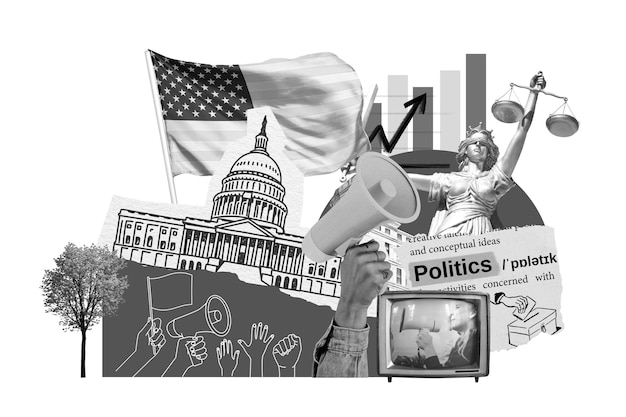Investigative Journalism & 2024 Election Misinformation

Anúncios
Investigative online journalism plays a crucial role in uncovering misinformation campaigns, particularly during sensitive periods such as the 2024 US election cycle, by employing fact-checking, data analysis, and source verification to expose falsehoods and inform the public.
Anúncios
In the digital age, the integrity of information is constantly under threat. This is especially true during election cycles, where misinformation can sway public opinion and undermine democratic processes. Investigative online journalism: Uncovering misinformation campaigns in the 2024 US election cycle has become a critical line of defense against these threats.
The Rise of Misinformation in the Digital Age
The internet has revolutionized the way we access and share information. However, this accessibility has also created fertile ground for the rapid spread of misinformation. During elections, this phenomenon is amplified, as malicious actors seek to influence voters through fabricated stories, manipulated data, and outright lies.
Anúncios
Understanding the scale of the problem is the first step in addressing it. Social media platforms, news websites, and online forums can all be used to disseminate false information. The speed at which these narratives spread makes it difficult to combat effectively.
The Impact of Social Media
Social media platforms are particularly vulnerable to misinformation campaigns. Their algorithms often prioritize engagement, which can lead to sensationalized and false stories being amplified. This creates echo chambers where users are only exposed to information that confirms their existing beliefs.
The Role of Foreign Interference
Foreign governments and other actors may also use misinformation campaigns to interfere in US elections. These campaigns can be designed to sow division, undermine trust in democratic institutions, and influence the outcome of the election.

- Rapid Dissemination: Social media allows false information to spread quickly and widely.
- Echo Chambers: Algorithms can create echo chambers, reinforcing existing beliefs and limiting exposure to diverse perspectives.
- Difficulty in Tracking Origins: The anonymity afforded by the internet makes it challenging to trace the source of misinformation.
In conclusion, the digital age presents unprecedented challenges in combating misinformation. Understanding these challenges is crucial for developing effective strategies to protect the integrity of elections and democratic processes.
The Role of Investigative Online Journalism
Investigative online journalism serves as a vital counterforce to the spread of misinformation. By using in-depth reporting, fact-checking, and data analysis, investigative journalists can expose falsehoods and provide the public with accurate and reliable information. This helps to inform voters and protect the integrity of the electoral process.
These journalists play a critical role in ensuring that the public has access to truthful information during elections. They dig deep to uncover the sources of misinformation, reveal the motives behind it, and expose the actors responsible.
Fact-Checking and Verification
Fact-checking is a cornerstone of investigative journalism. Journalists meticulously verify claims made by politicians, pundits, and other public figures. They use a variety of sources, including official documents, data analysis, and expert interviews, to determine the accuracy of information.
Data Analysis and Visualization
Data analysis is another key tool for investigative journalists. By analyzing large datasets, they can identify patterns and trends that might otherwise go unnoticed. Data visualization techniques can then be used to present these findings in a clear and compelling way.
- Uncovering Sources: Investigative journalists identify and expose the sources of misinformation campaigns.
- Verifying Claims: They meticulously fact-check claims made by public figures and online sources.
- Providing Context: Investigative reporting provides crucial context and analysis to help the public understand complex issues.
In summary, investigative online journalism plays an indispensable role in uncovering misinformation and providing the public with reliable information. Their rigorous methods and commitment to truth are essential for maintaining a healthy democracy.
Techniques Used by Misinformation Campaigns
Misinformation campaigns employ a range of sophisticated techniques to deceive and manipulate the public. Understanding these techniques is crucial for recognizing and combating them effectively. These methods often leverage psychological biases and technological tools to maximize their impact.
These campaigns are not always easy to spot, as they often mimic legitimate news sources and use emotionally charged language to appeal to their target audience.
Creating Fake News Websites
One common technique is to create fake news websites that look and feel like legitimate news sources. These websites often use similar branding, layouts, and writing styles to established news organizations, making it difficult for the average person to distinguish between real and fake news.
Using Bots and Trolls
Bots and trolls are often used to amplify misinformation and harass individuals who challenge false narratives. Bots are automated accounts that can rapidly spread messages, while trolls are real people who deliberately provoke and disrupt online conversations.

- Deepfakes: The use of AI to create highly realistic fake videos can severely damage reputations and spread false narratives.
- Microtargeting: Tailoring misinformation to specific demographic groups can increase its effectiveness.
- Emotional Manipulation: Using emotionally charged language and images can bypass critical thinking and promote rapid acceptance of false information.
In conclusion, recognizing the techniques used by misinformation campaigns is essential for protecting yourself and others from their harmful effects. By staying informed and critically evaluating the information you encounter online, you can help to counter the spread of false narratives.
Case Studies: Misinformation in the 2024 Election Cycle
Examining specific examples of misinformation campaigns in the 2024 election cycle can provide valuable insights into how these campaigns operate and the impact they can have. These case studies illustrate the diverse range of tactics used to spread false information and manipulate public opinion.
By analyzing these case studies, we can better understand the vulnerabilities of our information ecosystem and develop more effective strategies for combating misinformation.
The “Stolen Election” Narrative
One of the most prominent misinformation campaigns in recent elections has been the “stolen election” narrative. This false claim alleges that the 2020 election was rigged and that widespread voter fraud occurred. Despite numerous investigations and audits that have debunked these claims, they continue to circulate online and influence public opinion.
The Spread of Vaccine Misinformation
Another significant misinformation campaign has focused on vaccines. False claims about the safety and efficacy of vaccines have been widely disseminated, leading to vaccine hesitancy and contributing to the spread of infectious diseases.
- Examine the Actors Involved: Identify who is creating and spreading misinformation.
- Analyze the Tactics Used: Understand the techniques employed to deceive and manipulate.
- Assess the Impact: Evaluate the effects of misinformation on public opinion and behavior.
In summary, case studies of misinformation campaigns in the 2024 election cycle reveal the diverse tactics and harmful consequences of these campaigns. By learning from these examples, we can better prepare ourselves to combat misinformation in future elections.
Tools and Resources for Combating Misinformation
Combating misinformation requires a multi-faceted approach, involving the use of various tools and resources. From fact-checking websites to media literacy programs, there are numerous ways to protect yourself and others from the harmful effects of false information.
These resources are essential for fostering a more informed and resilient public. By actively using these tools, individuals can contribute to a more truthful and trustworthy information environment.
Fact-Checking Websites
Fact-checking websites such as Snopes, PolitiFact, and FactCheck.org are valuable resources for verifying the accuracy of claims made by politicians, pundits, and other public figures. These websites employ rigorous fact-checking methods and provide detailed explanations of their findings.
Media Literacy Programs
Media literacy programs are designed to teach individuals how to critically evaluate information and identify misinformation. These programs often cover topics such as source credibility, bias detection, and logical fallacies.
- Reverse Image Search: Use tools like Google Image Search to verify the authenticity of images and videos.
- Browser Extensions: Install browser extensions that flag potential misinformation and provide context for news articles.
- Critical Thinking Skills: Develop your critical thinking skills by questioning assumptions, evaluating evidence, and considering alternative perspectives.
In conclusion, a variety of tools and resources are available to help combat misinformation. By utilizing these resources and promoting media literacy, we can create a more informed and resilient public.
The Future of Investigative Online Journalism
As misinformation campaigns become more sophisticated, the role of investigative online journalism will become even more critical. In the future, investigative journalists will need to adapt to new challenges and utilize cutting-edge technologies to stay ahead of those who seek to deceive and manipulate the public.
The ongoing evolution of technology and communication platforms will continue to shape the landscape of misinformation. Investigative journalists must remain vigilant and proactive in their efforts to uncover and expose false narratives.
Artificial Intelligence and Machine Learning
Artificial intelligence (AI) and machine learning (ML) offer both opportunities and challenges for investigative journalism. AI can be used to automate fact-checking, detect misinformation, and analyze large datasets. However, AI can also be used to create deepfakes and generate convincing fake news articles.
Collaboration and Partnerships
Collaboration and partnerships between journalists, researchers, and technology companies will be essential for combating misinformation. By sharing knowledge, resources, and expertise, these groups can more effectively identify and address the root causes of misinformation.
- Enhanced Data Analysis: Journalists must leverage advanced data analytics tools to uncover hidden patterns and trends in misinformation campaigns.
- Improved Source Verification: Developing more reliable methods for verifying sources will be crucial in identifying and exposing fake news.
- Ethical Considerations: Journalists must adhere to ethical guidelines and ensure that their reporting is accurate, fair, and unbiased.
In summary, the future of investigative online journalism is bright, but it will require adaptation, innovation, and collaboration. By embracing new technologies and working together, investigative journalists can continue to play a vital role in protecting the integrity of information and promoting a more informed and democratic society.
| Key Point | Brief Description |
|---|---|
| 🔍 Investigative Journalism | Crucial for exposing falsehoods during elections. |
| 🤖 Misinformation Tactics | Include fake news sites, bots, and deepfakes. |
| ✅ Fact-Checking | Verifies claims to inform the public accurately. |
| 📚 Media Literacy | Teaches critical evaluation of information sources. |
FAQ
▼
Investigative journalism helps to uncover and expose misinformation, ensuring voters are well-informed. It holds public figures accountable and helps protect the integrity of the democratic process.
▼
Common tactics include creating fake news websites, using social media bots, spreading deepfakes, and employing emotionally charged language to manipulate public opinion.
▼
Check the source’s credibility, verify information with multiple sources, be wary of emotionally charged headlines, and use fact-checking websites to verify the accuracy of claims.
▼
Social media platforms can inadvertently amplify misinformation through algorithms that prioritize engagement, leading to echo chambers and the rapid spread of false narratives.
▼
Promote media literacy, support investigative journalism, enhance data analysis tools, improve source verification methods, and foster collaboration between journalists, researchers, and tech companies.
Conclusion
In conclusion, investigative online journalism: Uncovering misinformation campaigns in the 2024 US election cycle is paramount for safeguarding the democratic process. As misinformation tactics evolve, the role of investigative journalists becomes increasingly crucial in providing accurate, reliable information and fostering an informed public. Through fact-checking, data analysis, and collaboration, investigative journalism will continue to serve as a vital defense against the spread of falsehoods and manipulation.





